
Going from skinny to muscular is often times easier than what most naturally skinny guys think.
Even though I didn’t start out with the skinny physique myself, I have coached a few people who did, and they all started gaining weight, muscle and strength.
Often times skinny guys put a label on themselves as being “hardgainers” and hence that can’t build any noticeable muscle and strength. Sure, hardgainers do exist and we have seen them in research, but they are far fewer than what most people think, and even as a hardgainer it’s still possible to gain muscle and strength if the correct strategies and mindset are adopted.
In this transformation-how-to article you’re going to learn step by step how to go from skinny to muscular without giving up on living an enjoyable life in the process.
Let’s go!
SARMs Cutting Stack
- Cuts down excess fat
- Enhances metabolism
- Fast and effective results
- Fuels fat burning
Prime Shred
- Activates Body’s Fat-Burning Hormones
- Fast, whole body fat burning
- Vegetarian & vegan friendly
Table of Contents
Defining The Journey From Skinny To Muscular
Okay, so first of all let’s define the journey.
Knowing where you currently are and where you want to go will help you see the changes that needs to be made to your body. By knowing this you will set your expectations straight from the get go.
Now, the goal of most people who read my website and watch my videos is to build a physique that has a slim waist, thick shoulders and upper back, masculine square chest, well developed arms and athletic looking legs. A physique that looks something like this:

The good news is that in order to reach a physique similar to the ones in the picture, you are only going to have one goal, which is to get stronger in the gym in order to increase your muscle mass and in doing so achieve godlike musclar definition.
Skinny guys usually don’t need to go through the same extended bulking and cutting cycles as naturally fat or skinny fat individuals must do, simply because they have a much harder time storing body fat.
So, all you must do to look like the guys in the picture is to reach the following strength standards in the gym, while staying lean in the process:
The Strength Standards
- Incline Bench Press
5 reps – 1.25 x body weight - Weighted Pull-ups
5 reps – 50% of your body weight attached - Standing Shoulder Press
5 reps – 0.85 x body weight - Bicep Curls
5 reps – 0.65 x body weight - Waist
45-46% of height (8-10% body fat)
The process truly is this simple, but getting to these standards requires at least some time and effort, which is often where it gets tough for most people. But don’t let that stop you! If you decide to go for it, you will see huge changes within a few months.
Now, I don’t know what your current condition is but you’re likely not close to these standards yet. I’m sure you need to gain a lot of strength. But, I want you to remember that when starting out with the skinny physique you actually have one major advantage going for you, which is that you’ll have a hard time storing excess calories as body fat and you’ll find it much easier to gain muscle with minimal fat gain.
In fact, according to Lyle McDonald, during the first few weeks of eating at a moderate calorie surplus while training intelligently, naturally skinny guys can store as much as 60-70% of those surplus calories as lean mass even without training! Now isn’t that awesome?
Keep this fact in the back of your mind as you’re going through your transformation and you will find the process much easier and enjoyable!
So with that said, let’s take a look at exactly what you need to do.
How To Gain Muscle As A Skinny Guy
Look, gaining muscle is actually a pretty simple task. Get stronger and you will get more muscular, that’s it.
In order to lift a heavy weight for multiple reps your body must build muscle. Since muscle is a contractile tissue that allows our skeleton to move, lifting heavier weights over time becomes the obvious goal for achieving a more muscular physique.
In short, muscle is a byproduct of getting stronger. Get stronger and your muscles will get bigger. There’s no need to do a hundred different exercises and thousands of reps with low weights. What you must do is get stronger on a few certain key exercises over time and you will build an outstanding physique. In other words, keep training to the minimalistic end of things.
Okay cool, but what about diet? I though my problem was not eating enough?
Well, here’s the thing:
Training is going to be the thing that stimulates muscle growth, while nutrition “only” allows the muscle growth to take place once it’s been stimulated by training. So of course diet is important, but only if you are training correctly in the first place.
For this reason we are going to look at training first and diet second:
Step 1: Set Up Your Training Correctly
As I just mentioned, since training, or more specifically getting stronger is the thing that stimulates muscle growth, it’s very importnat that we set it up correctly, and do so in a way that’s optimal for someone starting out skinny. Let’s go:
Focus on a Few Key Compound Exercises
Using large compound exercises has been shown repeatedly to be the best way to quickly and effectively build whole body strength.
Here’s why:
- You can lift the most amount of weight with compound lifts
- Compound lifts stresses the whole body as one
- By doing compound lifts you use a range of motion that’s very natural to the body.
By doing heavy bench presses, overhead presses, pull-ups, rows, deadlifts and squats you will stress your whole body as one and in doing so get the largest stimulus for growth.
A lot of beginners believe that to build big arms, or a big back, or a big chest, they just have to focus on those muscle groups with isolation exercises. But unfortunately that won’t work very well.
The reason training with isolation exercises, especially in the beginning, won’t work very well can be explained with this image:

Have you ever seen someone with huge 18-inch arms that has a small upper body? I’m sure you haven’t, right?
If you want bigger arms, doing curls for days won’t cut it, getting big arms will happen as you are making your whole body big, and by focusing on getting strogner on compound exercises you will make your whole body bigger, including any specific muscles you want to grow as well.
So, to get big I recommend a training program that focuses on these compound exercises:
The 7 Compound Lifts For Building a Strong, Symmetrical & Proportional Physique
The most important lifts that I always recommend are the big four, or at least close variations to them, and these are:
- Barbell Bench Press
- Overhead Press (Barbell or Dumbbell)
- Squats
- Deadlifts (Regular, Sumo or Romanian)
These are the lifts that will drive the growth of your entire body the most. Once you got these covered, you should also use a few compound exercises that’ll build your proportions up as well, and these are:
- Pull-ups (Weighted)
- Rows (Barbell, Cable etc.)
- Incline Bench Press (Barbell or Dumbbell)
These 7 exercises are pretty much all you need to create an outstanding physique.
But, what about isolation exercises?
The purpose of isolation exercises is to target certain muscle groups that don’t get hit well with your compound lifts. So, there are a few isolation exercises that every training program should include and these are:
1. Dumbbell lateral raises for your side delts
Your side delts makes up a huge part of a strong looking physique. But, the only way to effectively train your side delts is to extend your arms out to the sides, like this:
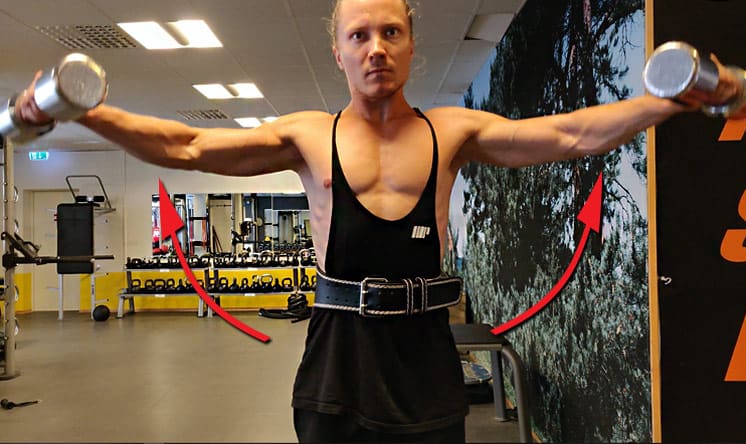
This movement puts your shoulders in a very bad positioning to lift heavy weights, risking injury. For that reason, you need to step away from compound lifts and use isolation exercises with lighter weights and higher reps to train your side delts safely and effectively. My go to exercise for this is Dumbbell lateral raises (as seen in the picture).
2. Hanging leg or knee raises for your abs
Another muscle group that should be trained with isolation exercises, are the one who people think are made in the kitchen, your abs!
Here’s the thing, abs are revealed in the kitchen, but just as with any other muscle, they’re built in the gym!
Now, heavy compound lifts will train your abs. But they’ll mainly train your internal, stabilizing abs, such as your transverse abdominis, and your internal obliques. In order to get that six pack to really pop, you must train your rectus abdominis directly, which is done with ab flexion exercises. My go to exerices for this is Hanging leg and knee raises:
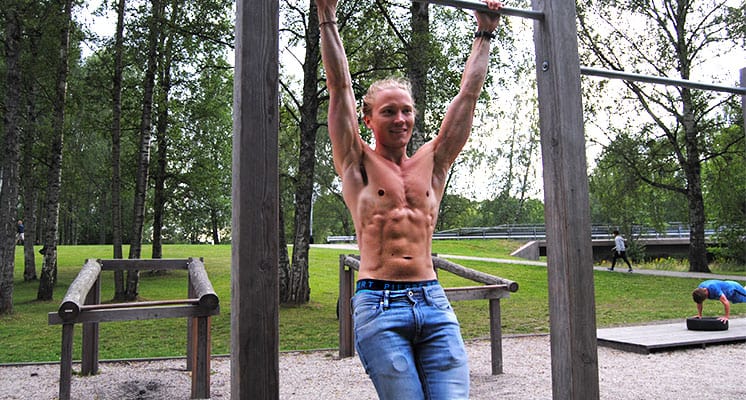
3. Standing or seated calf raises for your calves
I believe that decently developed calves are highly aesthetical. So, for that reason I like to do some standing or seated calf raises in every leg workout.
Now, some people have very high calf muscle insertions and might not be genetically gifted enough to build their calves noticeably. However, I do think that you should at least give your calves a try to see how they respond.
Train With The Correct Training Frequency
The fastest way to make strength and muscle gains as a beginner to novice trainee (0-2 years of training) is to train the key exercises mentioned above very often, about 2-3 times a week. There are two main reasons for this:
- The majority of the strength gains a person makes in the beginning are neurological. In the beginning you’re weak not just becuase your muscles are small, but mainly because your nervous system is not trained to recruit muscle fibers properly yet. So, if you train each main exercise 2-3 x a week you will have a lot of opportunities to practice the movement. This helps you make the neurological adaptations as quickly as possible so you can get to the point where muscle fibers must increase in size to contribute to strength gains. This is the point where your muscles must get bigger to contribute to strength.
- The reason you can train with higher frequencies, like 2-3 times per week, is since you initially don’t lift heavy weights, you don’t create much muscle damage either. For this reason you don’t need much recovery after training. Two days of rest are usually enough to allow you to recover and be able to perform better the next time you hit the gym.
I’m sure you’ve noticed this yourself. In the first weeks of lifting you set a PR each time you hit the gym. For this reason it make sense to train an exercise more often in order to make progress as fast as possible.
Lastly, since you will be training each muscle group two or three times a week with high intensity, your training volume (the number of exercises, sets and reps) done each session must be kept fairly low. If you don’t keep volume low, you won’t be able to recover as well.
I recommend that you do three workouts per week on non consecutive days. For example on Monday, Wednesday and Friday.
Keep Your Session Training Volume On The Low End
To maximize strength gains you want to keep your workouts short and intense. This means you want to stick to about four to five exercises per workout session and three sets per exercise.
That’s a total of 12-15 sets per workout, which sounds super short, but it will allow you to come back into the gym with incredible strength each time. Which is the key for quick growth in the beginning.
Train Within The 4-10 Rep Range
Training within the 4-10 repetition range on your compound exercises is perfect when it comes to maximizing strength and muscle growth. By training with 4-10 reps you’ll achieve the greatest balance between effectively getting in enough training volume, while also working with heavy enough weights to maximize mechanical tension on the muscles.
Training with weights that are medium to heavy will stimulates more mechanical tension (stretching and contracting under load) than metabolic fatigue (the pump) and this is highly beneficial when it comes to increasing strength.
For isolation exercises it’s usually recommended to train with a bit higher repetitions, mainly for injury prevention reasons. Around 12-15 reps is the sweet spot for most isolation exercises.
Rest Three to Five Minutes Between Sets
Make sure you rest at least three minutes between your sets. Research shows that by resting longer (3 minutes), you gain more strength and muscle.
By taking long rest periods you fully recover between your sets, which allows you to lift as much weight as possible for as many reps as possible on all your sets. If you’re too fatigued you won’t build strength and muscle as efficiently.
Focus on Progressive Overload
Out of all the things you can do in the gym, this is hands down the most important thing to set up correctly. You see, the main driver of muscle growth is progressive overload (lifting heavier and heavier weights over time).
After the first few weeks in the gym you will come to a point where your muscles will only grow from you getting stronger. For this reason, the main focus during your workouts should be on gaining strength in a medium rep range, like 4-10 reps per set.
Here’s a video explaining the power of progressive overload more in depth:
Use a Two Day Workout Split
To maximize strength and muscle growth I recommend using a two day upper lower body split. One day will focus entirely on the upper body and the other day on the lower body.
By using a two day workout split and working out three days per week, you will perform every workout about every 4-5 days. Here’s how your weeks will look:
- Week One: Workout A, Workout B, Workout A
- Week Two: Workout B, Workout A, Workout B
Hitting your muscle groups every 4-5 days is a perfect training frequency for optimal strength and muscle gains.
The Skinny Guy Transformation Workout Plan
Workout A – Upper Body
- Bench Press – 3 sets of 4-6 reps
- Weighted Chins – 3 sets of 4-6 reps
- Standing Overhead Press – 3 sets of 6-8 reps
- Cable Rows – 3 sets of 6-8 reps
- Incline Dumbbell Bench Press – 3 sets of 6-8 reps
- Dumbbell Lateral Raises – 3 sets of 12-15 reps
Workout B – Lower Body
- Barbell Squats – 3 sets of 4-6 reps
- Romanian Deadlift – 3 sets of 4-6 reps
- Leg Press – 3 sets of 6-8 reps
- Hanging Leg or Knee Raises – 3 sets of 12-15 reps
- Seated Calf Raises – 3 sets of 12-15 reps
Here’s how to progress and get stronger over time with this routine:
- Train 3 times per week on non-consecutive days. For example:
- Monday – Workout A
- Wednesday – Workout B
- Friday – Workout A
- Monday – Workout B
- Wednesday – Workout A
- Friday – Workout B
- Rest 3-5 minutes between sets on compound exercises.
- Rest 1-2 minutes between sets on isolation exercises.
- When you hit the required reps for all sets, increase the weight with 2.5 kg (5 lbs) on all sets the following workout. If you lose a few reps on the upcoming workout, no worries. Your goal for the following workout is to add back the reps in those last sets so you can increase the weight once again. This is the MOST important part to focus on in the training. If you don’t try your best to get stronger over time, you won’t build much muscle either.
- Use a lifting app or paper to track your progress.
- After a few months (around 3-6) you will adapt and be able to handle more training. At this point you can and should update your routine to a more advanced one.
Okay so that’s pretty much it regarding training. If you follow the protocol above you will provide the best stimulus for muscle growth at your stage. In fact, you will be blow away by how much strength and muscle you will be able to build with this kind of routine.
Once the training is set up, only then will the diet become important. So, let’s look at that now.
Step 2: Set Up Your Diet Correctly

Even though training is king for muscle growth, diet is certainly queen, and without it you wouldn’t reap the benefits that training sows.
Diet is also where most naturally skinny guys struggle. The thing they struggle with most is the first and most important factor for muscle growth, which is being in a calorie surplus.
How to Set up Your Calorie Surplus
So, you have laid out the ground work with your training and in doing so kickstarted your muscle building process. Now it’s time to fuel that process with food!
The calorie intake I recommend to maximize muscle growth is this:
- 10-15% above maintenance calories
Use this formula to find out your maintenance calories:
- 15 x lbs of body weight // 33 x kg of body weight
By eating 10-15 % above maintenance most skinny guys will be able to gain 2 to 3 lbs (1-1.5 kg) of lean mass per month at the beginning of the bulking phase and then about 1.5 to 2 lbs (0.7-1 kg) per month for the remainder of the first year.
As long as you make strength gains in the gym and eat enough, you WILL gain muscle and size.
Hardgainer, true or not?
By now I’m sure some of you might wonder:
What if I’m a hardgainer?
What if I have tried eating in a surplus but I still don’t gain any weight?
Well, I hear you so allow me to explain what’s likely going on here.
First of all, you can’t eat in a calorie surplus and not gain weight, that is physiologically impossible. If a person eats more calories than what the body can expend over a certain time frame, weight gain will occur. This is known as the law of thermodynamics.
The reason why a lot of skinny guys find it hard to gain weight is likely because one or a combination of the following things:
1. They eat less than they think
They might eat a lot of food in one meal but they get extremelly full so they end up eating very little for the remainder of the day, or even the next day. As a result, the daily or weekly average calorie intake ends up close to, or even below maintenance.
2. They eat tons of low calorie foods
Eating a ton of food doesn’t necessarily mean eating a ton of calories.
I once helped a client who struggled putting on weight despite telling me he was eating as much as he could. I took a look at his diet and realized that he was mainly eating lean protein sources like chicken breast and lean meats, potatoes, pasta and a lot of veggies. The problem for him was obvious, he simply ate a large quantity of food containing very low calories. Great meals for fat loss, but not so much for gaining weight.
The way I helped him gain weight was to add sauces to his meals (something he actually wanted to have, but thought was unhealthy). This allowed him to add about 500-700 calories extra per day from only 100 grams of easily digestable and tasty sauce.
3. They respond strongly to NEAT and burn off the excess energy
NEAT (Non-Exercise Activity Thermogenesis) is energy expended through all the spontaneous and subconscious movements we make, such as playing with objects, bumping your hand on your leg when you sit still, fidgeting etc. You know all these kind of movements people make without even thinking about it.
What’s interesting is that in research they’ve seen that the energy expended through NEAT varies drastically between different individuals.
In fact, one study showed that some people’s NEAT tends to go up a lot when they overeat in order to burn of the excess energy and in doing so defend agains weight gain. Another study showed that the highest NEAT responder burned 692 kcal per day more that what he usually did when he was fed a surplus of 1000 kcal per day. So for this guy the 1000 kcal surplus that he theoretically was taking in, was actually a 308 kcal surplus only. The 308 kcal surplus still led to the weight gain expected of 308 kcal extra per day though.
So, as you can see, these three things can greatly impact whether or not you are actually in a calorie surplus.
How to Ensure That You’re in a Calorie Surplus
If you truly want to start building muscle and strength you must find a way to ensure that you are in a calorie surplus. The only way to truly know this is by weighing yourself on a weekly basis. Your goal is to gain 2 to 3 lbs (1-1.5 kg) per month but not more than this. If you find yourself not gaining at this rate then you must adjust your caloric intake.
The best way to adjust your calories is by using a food tracking app like MyFitnessPal. If you get into the habit of using MyFitnessPal and also weighing yourself each week you have done everything you can to ensure success!
If you want to learn more about measuring and tracking your progress check out this post. In the post I explain how to track fat loss progress, but don’t get confused by that, it’s the exact same process to track weight gain as well.
Eat Enough Protein, But Not Too Much
After your calories is checked the second thing you must do is ensure optimal protein intake. What’s important here is that you eat enough protein but not too much.
Protein is highly satiating which often makes it hard for skinny guys to stay in a calorie surplus, simply because they’re getting too full. Also, a protein intake that exceeds 1.8 grams per kg (0.8 grams per lb) of body weight per day is unnecessary during a calorie surplus. Research has shown that the optimal protein intake when bulking lies between 1.6-1.8 grams per kg (0.6-0.8 grams per lb) of body weight per day.
You can easily track your protein intake using MyFitnessPal. There’s no need to care too much about the other macros carbs and fat. Just let these end up where they do. But I recommend that you eat a fairly balanced intake of both carbs and fat.
What About Fancy Dieting “Tricks”?
Don’t get too confused over fancy dieting tricks like weird meal frequencies, timing, supplements and so on. These things are far less important than your overall daily calories and protein. By eating the correct calories and protein on a daily basis you will account for 90 % of your results.
With that said though, if you find that you can easier eat all the calories you need with 6 meals per day then that’s a good choice for you. But, on the other hand, if you find 2 meals intermittent fasting style to work best then that’s obviously a good choice for you.
Same goes for supplements. If you struggle eating enough calories or protein from a normal diet, then a cheap gainer or carb/protein powder can help you bump up your calories, so that you can achieve the surplus you need to gain weight.
What’s Next?
So, there we go. If you stick to the guidelines outlined in this post you will start to see great results!
Now, if you want to maximize your results, by gaining hard dense muscle without getting fat and more importantly be held accountable during your transformation journey, then I highly recommend the ShredSmart Program authored by Radu Antoniu.
I have used the bulking protocol inside his program during my last two lean-bulking phases and it works insanely well. Here’s my before and after on this program:
Before and After Photos
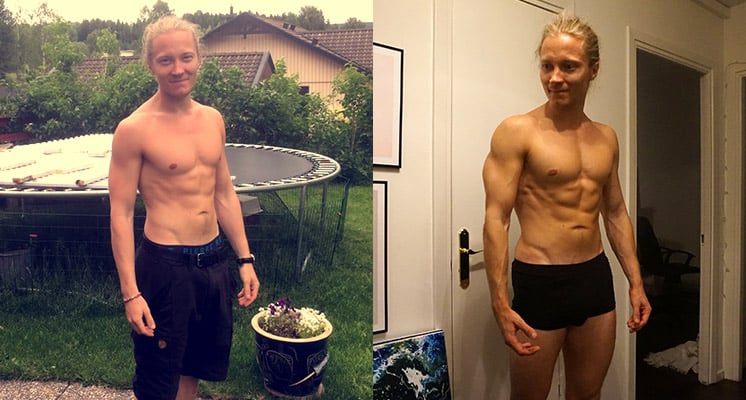
The picture to the left was taken in April 2016 and the picture to the right was taken in February 2017. I gained a total of 14 lbs in 9 months and then did a 4 week cut. My total lean muscle gain was around 8-10 lbs over these 9 months. I’m not trying to toot my own horn here, just want to demonstrate how powerful Radu’s approach is for gaining lean muscle mass with minimal fat gain.
So, if you’re interested in jumping on the program, you can learn more about it here.
Cheers,
Niklas


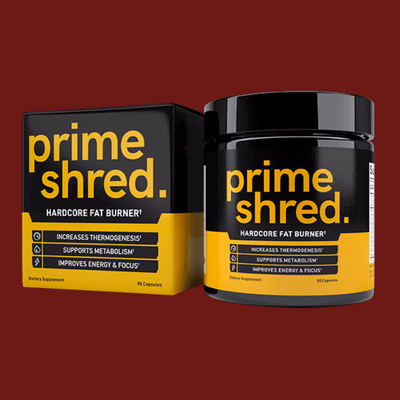
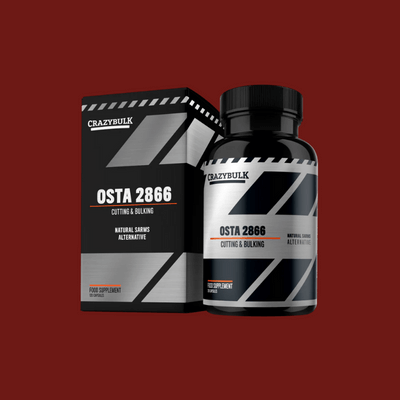
damn boy, thanks for the advice brotha